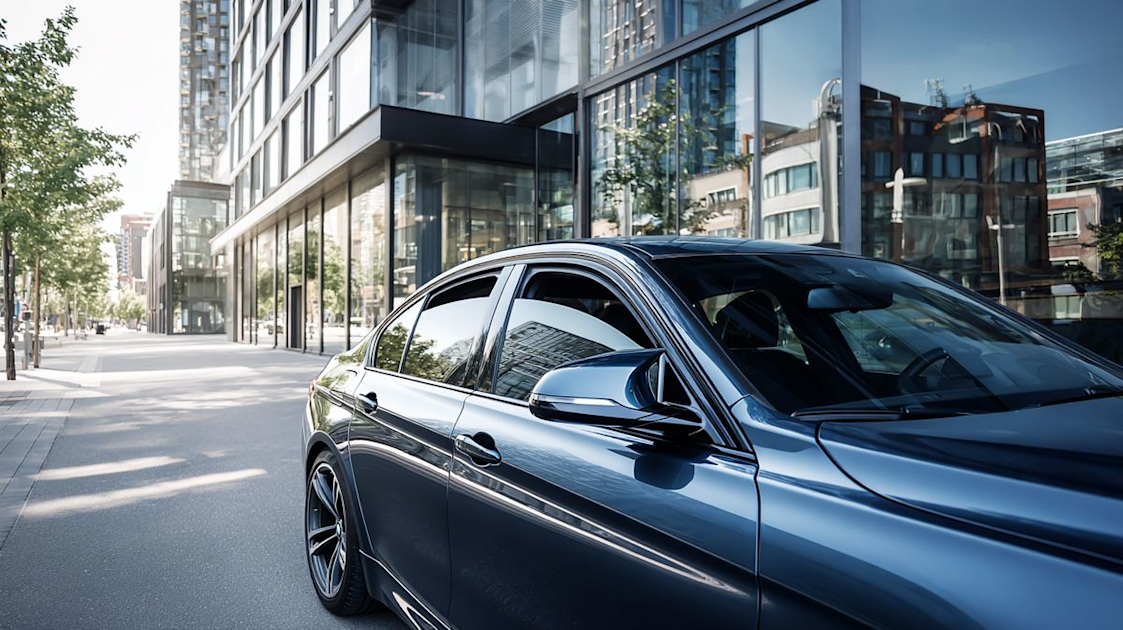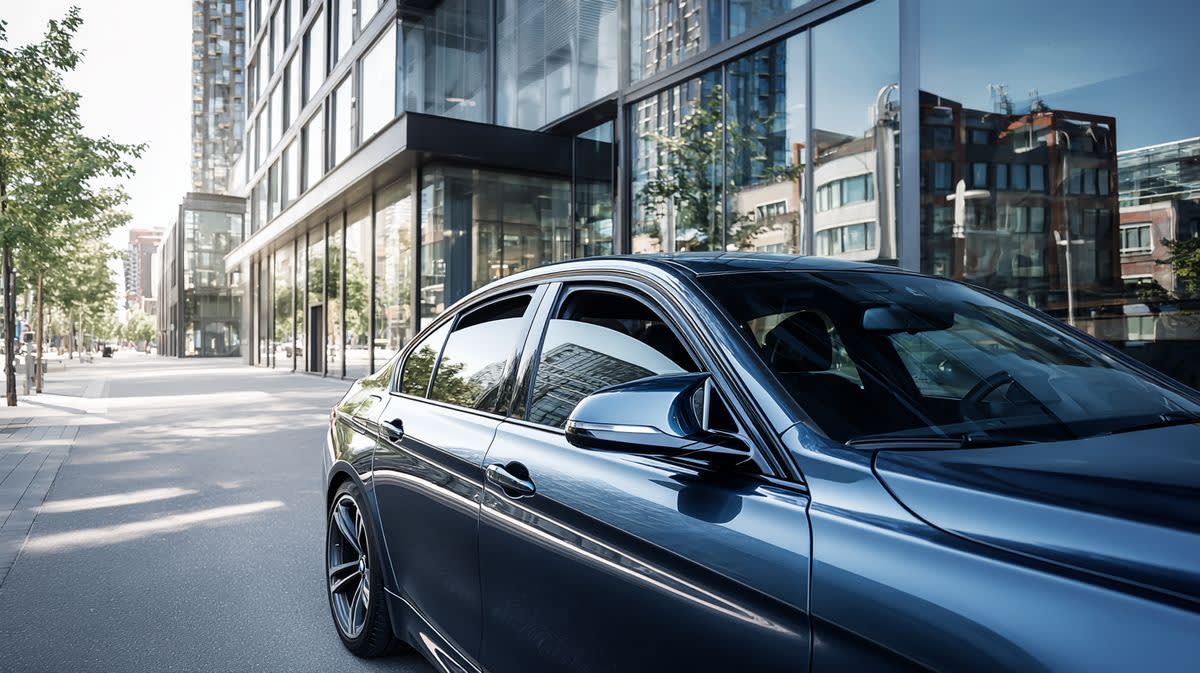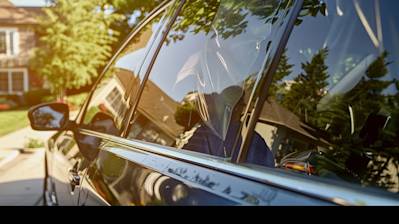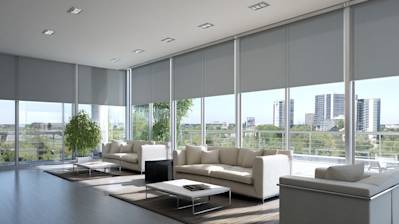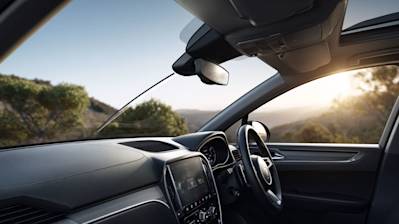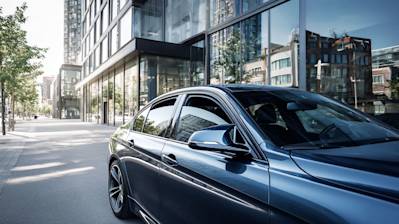Car tinting percentages can seem like a complex subject, but breaking it down makes it much easier to grasp. Whether you're tinting your car windows for style, privacy, or UV protection, understanding the nuances of tint percentages is crucial.
What Are Car Tinting Percentages?
Car tinting percentages refer to the amount of light that window tint allows to pass through your car windows. This is known as Visible Light Transmission (VLT). The percentage indicates how much visible light can penetrate the tint film. So, a 50% tint allows 50% of the light to pass through, while a 15% tint lets only 15% of the visible light in.
Low Vs. High Tint Percentages
The lower the car tinting percentage, the darker the tint. A lower percentage, like 5%, indicates a very dark tint that allows minimal light to enter. This level of tint is often referred to as "limo tint" because it's typically used in limousine windows for maximum privacy. On the contrary, a high tint percentage, such as 70%, results in a lighter tint, permitting more light to pass through the windows.
The Science Behind Car Tinting
How Tint Percentages Work
Window tint film is usually made from a combination of polyethylene terephthalate, which is a strong, clear, and lightweight plastic. The film is coated with layers of metals or dyes that block or absorb light. This process is finely tuned to achieve the desired tint percentage. For instance, a lower percentage indicates a higher concentration of metals or dyes in the film, creating a darker tint.
UV Protection and Heat Rejection
One of the significant benefits of car tinting is its ability to block harmful UV rays and reduce heat inside the vehicle. The science behind this involves the materials used in the tint. Ceramic tints, for example, provide excellent UV protection and heat rejection while maintaining a lighter appearance, which means they can have a higher tint percentage with similar benefits to darker films.
Choosing the Right Tint Percentage
Factors to Consider
When selecting a car tinting percentage, several factors should guide your decision:
Legal Restrictions: Tint laws vary by state or country, and it's crucial to choose a tint percentage that complies with these regulations to avoid fines and hassles.
Climate: Your location's climate can influence your choice. Hotter climates might call for a lower percentage to keep your car cooler.
Personal Preference: The desired level of privacy and aesthetics also plays a role in choosing the right tint for your vehicle.
Balancing Aesthetics and Functionality
Finding the perfect car tinting percentage involves balancing the aesthetic appeal of your vehicle with functional aspects such as UV protection and glare reduction. Some car owners prefer darker tints for a sleeker look, while others might prioritize high VLT films to maintain maximum visibility and safety during night driving.
Common Tint Percentages and Their Applications
5% Tint
Known as limo tint, 5% is one of the darkest available car tint percentages. It offers maximum privacy but might not be suitable for everyday driving conditions due to reduced visibility, especially at night.
20% Tint
A 20% tint provides a good level of privacy while still allowing for adequate visibility under most conditions. It's a popular choice for those who want a balance between privacy and functionality.
35% Tint
Often seen as the sweet spot for many drivers, a 35% tint offers excellent UV protection and glare reduction without making the windows too dark, ensuring safe driving under various conditions. It's commonly accepted in most areas due to minimal impact on visibility.
50% Tint
50% tint doesn’t significantly darken windows but still provides excellent protection against heat and UV rays. It's an ideal choice for drivers who prefer a lighter tint or live in regions where darker tints are not legally permissible.
Legal Considerations
State and Country Regulations
When it comes to car tinting percentages, understanding local laws is crucial. Each state or country has specific regulations dictating the allowable VLT on different windows of a vehicle. These laws are in place to ensure safety, especially for law enforcement officers who need a clear view inside vehicles for security reasons.
Consequences of Non-Compliance
Ignoring these regulations can result in fines and may require you to remove the illegal tint. This can be both costly and time-consuming. It’s always best to consult with a car tinting professional who is familiar with local laws to ensure your vehicle remains compliant.
The Role of Professional Tint Installation
Benefits of Professional Tinting
While DIY kits for window tinting are available, hiring a professional ensures a quality job and longevity of the tint. A professional installer has the tools and expertise to apply the film without bubbles or imperfections, ensuring even coverage and long-lasting results.
Warranty and Aftercare
Professional installations often come with a warranty that guarantees the product and the quality of the work. It's also essential to follow proper aftercare instructions, such as not rolling down windows for a few days post-installation, to ensure the tint adheres well to the windows.
Car Tinting Technology Advancements
Modern Tinting Solutions
Advancements in car tint technology have introduced new materials and processes that offer better performance and durability. Ceramic tints, for example, provide superior UV and heat rejection without the signal interference that can occur with metallic tint films.
Smart Tints and Their Future
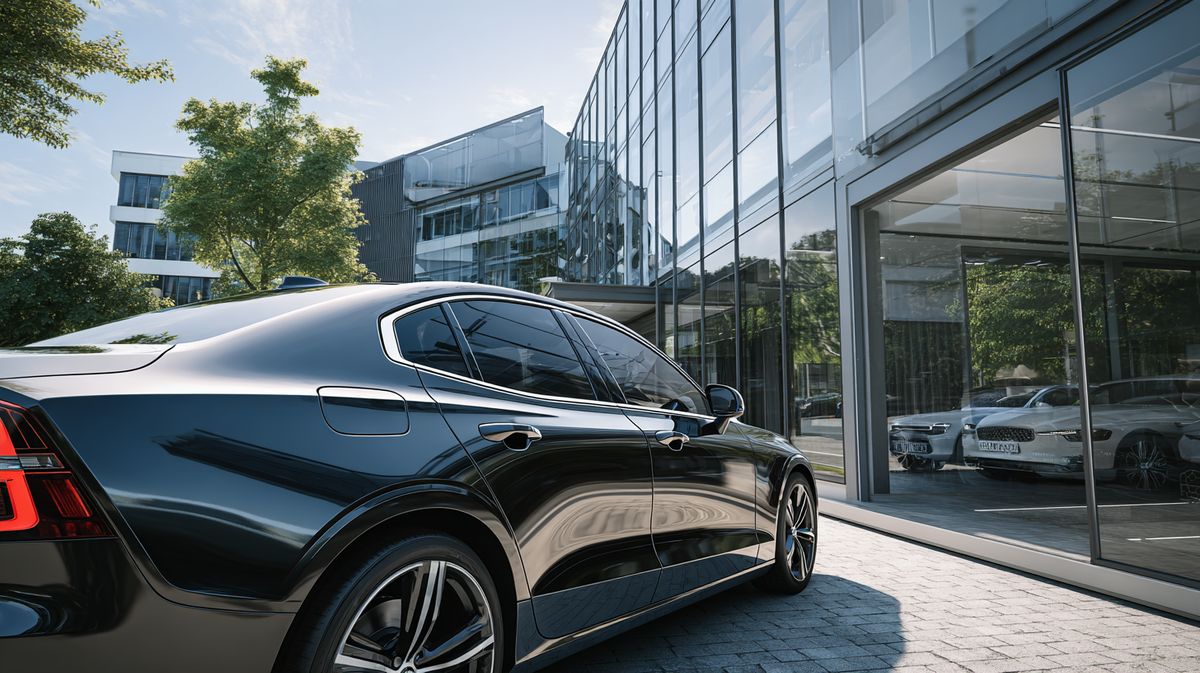
Frequently Asked Questions about Car Tinting Percentages
What are common car window tint percentages?
Common tint percentages range from 5% to 90%, with 5% being the darkest. The most popular options include 5%, 20%, 35%, 50%, and 70%. Each percentage offers varying levels of visibility and solar performance, so it's crucial to consider what suits your needs best.
Is a 20% tint darker than a 35% tint?
Yes, a 20% tint is darker than a 35% tint. As the percentage of the tint decreases, the film becomes darker and allows less light to pass through. A 20% tint is more privacy-friendly compared to a 35% tint, but it may be more challenging to see through at night.
What is legal tinting percentage?
Legal tinting percentages vary by location, as different states and countries have specific regulations. It's vital to check your local laws to ensure you comply with legal requirements. Generally, front windows have stricter limits compared to rear windows and windshields.
Are all car window tinting percentages legal?
Not all window tint percentages are legal, and exceeding the legal limit can result in fines or the requirement to remove the tint. In some areas, certain tint levels or reflective tints may be prohibited, so it's essential to stay informed about your local laws before making a decision.
What tint percentage is best for heat reduction?
For optimal heat reduction, many prefer a tint around 20% to 35%. These percentages are effective in blocking a significant amount of solar energy, thus reducing heat buildup in your vehicle. Individual preferences and legal restrictions should also be taken into account.
Does a lower tint percentage mean more UV protection?
Not necessarily. While darker tints often block more light, UV protection is more reliant on the quality and type of film used rather than the darkness of the tint. Many high-quality tints offer nearly 100% UV protection regardless of the percentage.
Can a 70% tint provide privacy?
A 70% tint is relatively light and primarily used for reducing glare and providing UV protection. It offers minimal privacy as it allows most light to pass through. If privacy is a top priority, consider opting for darker tints like 20% or 35%.
How do I choose the right tint percentage for my car?
Choosing the right tint percentage depends on several factors including your aesthetic preference, legal restrictions, privacy needs, and purpose (e.g., glare reduction, heat rejection). Weigh these considerations and test different options to find your perfect match.
How does tint percentage affect driving at night?
Darker tint percentages such as 5% or 20% can significantly reduce visibility at night, potentially making it challenging or unsafe to drive. If you often drive after dark, consider higher percentages like 35% or lighter to maintain clear visibility while adhering to legal limits.
Does windshield tinting use the same percentages as side windows?
Windshield tinting typically uses a higher percentage compared to side windows due to legal restrictions and visibility needs. Many opt for 70% or lighter films for windshields to ensure clarity and reduce glare, while maintaining some solar protection.
Can the same tint percentage look different on different vehicles?
Yes, the perceived darkness of a tint can vary based on factors such as vehicle type, interior colors, and the amount of existing sunlight filtering into the car. Lighter interiors may make tints appear darker, while darker interiors might have the opposite effect.
Are ceramic tints better despite their percentages?
Ceramic tints are often regarded as superior because they block more infrared light (heat) and UV rays compared to traditional films, regardless of their percentage. They don't rely on metal particles, so they don't interfere with electronic devices, making them a popular choice despite being typically more expensive.
Can tinted windows bubbles affect tint percentage effectiveness?

Pros
Improved Aesthetics
Sleek Appearance
Tinting your car windows, particularly with the right percentage, gives your vehicle a sleek and polished look that can make it stand out. Whether you're opting for a subtle tint or something a bit darker, it often enhances the overall aesthetic appeal of your car.
Customization
With various tint percentages available, you can customize your car to match your style or preferences. This personal touch can make your vehicle feel more like "yours" and less like just another car off the lot.
Privacy and Security
Enhanced Privacy
One of the primary benefits of car tinting is increased privacy. Depending on the percentage, darker tints can make it difficult for people outside to see into your vehicle. This extra level of privacy can make you feel more comfortable and secure, especially when parked in public areas.
Theft Deterrent
Tinted windows can act as a deterrent to thieves since they can obscure the view of valuable items inside your car. When potential thieves can't see what’s inside, they might be less likely to break in.
Protection from UV Rays
Reduced UV Exposure
Car tints can block a significant amount of harmful ultraviolet (UV) rays from the sun. This can protect both your skin from potential sun damage and your car’s interior from fading and cracking over time.
Health Benefits
By blocking UV rays, tinted windows can help in reducing the risk of skin cancer and other skin-related issues. This can be particularly beneficial for individuals who spend a lot of time driving.
Temperature Control
Cooler Interior
Tinted windows can significantly reduce the heat inside your car by blocking out direct sunlight. This can create a more comfortable environment, especially during hot summer months. It also reduces the dependence on air conditioning, potentially improving fuel efficiency.
Energy Efficiency
By keeping the car cooler, tints can reduce the need for air conditioning, saving on fuel and thereby helping the environment a little bit in the process. Not only does this conserve energy, but it can also save you money on gas.
Safety Enhancement
Window Shatter Protection
Some window tint films can hold the glass together if it shatters during an accident. This can reduce the risk of injury from flying glass shards, adding an extra layer of safety for the occupants.
Cons
Legal Restrictions
Varying Laws
One of the significant downsides of car tinting is the complex legal landscape surrounding it. Different states and countries have varying regulations about which tint percentages are permissible. Navigating these laws can be challenging, and failing to comply can result in fines or the need to remove the tint.
Inspection Challenges
If you have your car inspected in a region with strict tinting legislation, you might face issues passing if your tints are too dark according to local laws. This can be particularly inconvenient if you move to a different area or when selling your car.
Reduced Visibility
Night Driving Issues
While a darker tint may look great during the day, it can reduce visibility at night, making it harder to see through your windows. This could pose a safety risk when driving in poorly lit areas or during adverse weather conditions.
Adverse Weather Conditions
In situations like heavy rain, fog, or snow, darker window tints can impair your ability to clearly see what’s happening around your car. This reduction in visibility can affect reaction times and overall driving safety.
Potential for Damage
Improper Installation
If window tints are not installed correctly, they can bubble, peel, or crack over time. This not only looks unattractive but might also require costly repairs or re-installation to correct.
Damage to Defroster Lines
Tinting that’s applied to rear windows without careful application can damage defroster lines which might affect your ability to defrost your rear window effectively.
Cost Considerations
Initial Investment
Quality tints and professional installation can be costly. While this is an investment into your vehicle, the initial cost can be a deterrent for some car owners, especially if you don't see immediate benefits.
Ongoing Maintenance
While tints generally require low maintenance, improper care or cleaning with harsh products can shorten their lifespan. Replacement of damaged tints can become an unexpected expenditure as well.
Impact on Electronics
GPS Interference
In some cases, certain metalized tints can interfere with GPS or mobile phone signals by blocking the signals from getting through the glass. This can be a significant inconvenience, particularly if you rely heavily on navigation systems or hands-free phone functions while driving.
Resale Issues
Potential Buyer Turn-Off
Some buyers might be turned off by tinted windows, particularly if they are darker than legally permitted or if they prefer a more transparent look. This can potentially limit your market when trying to resell your vehicle.
Legal Compliance
When selling your car in a different jurisdiction, the tint percentage might need adjustment to comply with the local tinting laws. This can incur additional costs and hassle before being able to sell your vehicle.

Myths and Misconceptions About Car Tinting Percentages
Misconception: Darker Tints Always Provide Better UV Protection
UV Protection vs. Tint Darkness
One common misconception is that the darker the car window tint, the better it protects against harmful ultraviolet (UV) rays. However, the darkness of the tint does not necessarily correlate with the UV protection it offers. Advanced window films are designed to block up to 99% of UV radiation regardless of whether the tint is light or dark. These films use specific materials and technologies to enhance UV blockage, which means you could achieve excellent UV protection with a clear or lightly tinted film.
Myth: Car Tinting is Only for Aesthetics
Functionality of Window Tints
Many people believe that car window tinting is purely for aesthetics, but this is a surface-level understanding of its benefits. Besides giving your car a sleek appearance, tinting serves several key functional purposes such as reducing glare, heat rejection, energy savings, and added privacy. High-performance tints also reinforce glass, making it less prone to shattering, which can be a critical safety feature.
Misconception: Tint Percentages Indicate Privacy Level
Visibility vs. Tint Percentage
It’s easy to assume that the percentage of a car tint directly indicates the level of privacy it provides. The percentage actually refers to the amount of visible light transmission (VLT) allowed through the film. A lower percentage means less light is transmitted, resulting in a darker tint. While darkness can imply more privacy, it’s vital to consider that visibility doesn't always equate privacy, especially at night when interior lights can make the inside more visible.
Myth: Tinting Will Ruin Your Car’s Resale Value
Resale Value Considerations
Many prospective car sellers fear that window tinting will negatively impact their vehicle’s resale value. In reality, professional and legally compliant tinting could enhance resale value. This is especially true if tints are done to protect the interior from UV damage, which can prevent fading and maintain the condition of the upholstery and dashboard. As long as the tint matches market demands and isn’t overly personalized, it can actually appeal to buyers looking for additional features.
Misconception: Factory Tinted Windows are the Same as Aftermarket Tinting
Factory Tint vs. Aftermarket Tint
Factory tinted windows and aftermarket window films serve different purposes. Factory tint is typically achieved by adding a dye to the glass during manufacturing, offering privacy and reducing glare. However, it doesn’t provide substantial UV or heat protection. Aftermarket films can be chosen for specific characteristics, like UV protection or heat rejection, and offer a greater customization level, allowing car owners to tailor the performance of their car windows more precisely.
Myth: All Tints Look Purple Over Time
Quality and Technology in Modern Tints
In the early days of window tinting, it was not uncommon for films to turn a purple hue as the dye degraded over time. However, advancements in tinting technology have produced durable, fade-resistant films. Modern tints often incorporate metallic or ceramic components that not only enhance performance but also maintain their color integrity over years. High-quality tints resist turning purple and maintain their look and performance with the proper maintenance.
Misconception: Higher Tint Percentages are Legal Everywhere
Legal Implications of Tint Percentages
It’s important to know that laws regulating tint percentages can vary significantly from region to region, often determined by state or country. While some areas may allow very low VLT percentages, others may have stricter requirements for safety reasons, such as ensuring police officers can see inside vehicles during traffic stops. Failing to adhere to local tinting laws might not only lead to fines but also require removal and replacement to meet the legal standards.
Myth: Dye-Based Tints are the Only Budget Option
Different Budget Choices
Though dye-based tints are often viewed as the most economical choice, they aren't the only budget-friendly option. There are affordable metallic and hybrid (a combination of dye and metallic) films available that offer better UV protection and heat rejection than basic dyed films. Additionally, ceramic tints, although more costly upfront, can prove to be cost-effective over time due to their superior durability and no risk of interference with electronic devices.
By breaking down these myths and misconceptions around car tinting percentages, car owners can make more informed decisions when choosing the right window film for their needs, leading to better performance, compliance with legal standards, and overall satisfaction with their tinting investment.
Summary
Car tinting percentages can really change up the look and feel of a car. Depending on the percentage you choose, you can make your car look sleek and mysterious or just add a touch of privacy. People often go for different tint levels based on what they think looks good, how much privacy they need, and sometimes, what the law allows. It's pretty cool how something as simple as tint can make such a big difference.
When you're considering car tinting percentages, it's also about how bright or dim you want the interior to be. A lower percentage means a darker tint, which can help keep your car cooler and protect the interior from sun damage. It’s like choosing the right pair of sunglasses for your car. Of course, the legal aspect can't be ignored. Laws vary by location, and it's important to choose a tint that keeps you out of trouble, all while meeting your style needs.
At the end of the day, car tinting percentages are all about finding that sweet spot between style, function, and legality. Whether you're looking to make a statement, keep things cool, or simply reduce glare, there's a tint percentage that's just right for you. It's always a good idea to do a little research or chat with a professional to find out what works best for your specific situation.
About A+ Window Tinting
Welcome to A+ Window Tinting, the premier destination for top-quality window tinting services in Roseville, CA. With a passion for enhancing both style and comfort, we take pride in transforming your vehicles, homes, and businesses through our exceptional tinting solutions. Our team of skilled professionals is dedicated to delivering superior craftsmanship and unmatched customer satisfaction. Whether it's reducing glare, increasing privacy, or enhancing energy efficiency, we've got you covered with the best products and expertise in the industry. At A+ Window Tinting, we believe in going above and beyond for our clients, ensuring every tint job not only meets but exceeds your expectations. Stop by our shop and experience the A+ difference today!

